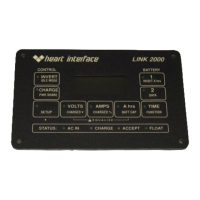5/31/96
16
HOW TO USE LINK 2000 METERS
BATTERY MANAGEMENT PHILOSOPHY:
Recharge When the Battery is 50% Discharged!
The LINK 2000 Meter is a guide to the battery's state of charge. Our Mid-Capacity
Rule says you should begin charging when your LINK shows that 50% of battery capacity has
been consumed. In Marine and RV systems, which are trying to minimize charging time with
an engine driven alternator or generator driven charger, the battery is normally charged only to
the 85% level. This means only 35% of the battery capacity is actually available for use. The
Mid-Capacity rule is a very conservative approach to battery use. Occasionally discharging a
battery more deeply is perfectly acceptable. The Mid-Capacity rule is intended as a design
and operating guideline, not a law which must be obeyed without exception.
We recommend synchronizing your LINK 2000 Meter to the 100% charged level of the
battery. You should begin recharging when 50% of the your battery capacity has been consumed.
When recharging from an engine driven alternator or generator supplied battery charger
you do not have to charge until the meter reads 0 Amp-hours consumed. You may cease
charging when the LINK 2000 Meter is displaying that 15% of the battery capacity is still
consumed. See example below. When you plug back into AC power, or when your Alternative
Energy production exceeds demand, the remaining Amp-hours consumed will be replaced.
MANAGING A TWO BATTERY SYSTEM
With a two battery system we recommend using battery #1 until you consume 50% of
its capacity, then switch to battery #2 and use 50% of it. When both batteries are 50% discharged
it is time to charge. You should never leave either battery partially discharged for more than a
few days.
Suppose you have two 200 A hr batteries for a total system capacity of 400 A hrs
and you have synchronized your LINK 2000 Meter to 100% charged batteries. . You would
use battery #1 until the LINK 2000 Meter showed that you had used 50% (the display would
show -100A hrs). You would then use battery #2 until you had used 50% of it (-100A hrs). At
this point charge both batteries up to about the 85% level (-30 A hrs on each). If you have other
reasons to continue running the engine or plug back into AC power you may continue charging
until the meter reads zero.
OVER-CHARGE AMP-HOURS
If the battery is 100% charged, and the LINK 2000 Meter is in sync, over-charge
A hrs are displayed as positive. Some accumulation of over-charge Ahrs is normal with systems
continuously connected to a charger. For example: A 100 A hr battery at the Float voltage,
will normally have less than .1 A flowing into it. This means that a maximum of 2.4 Ahrs
of over-charge would accumulate in a 24 hour period. If your battery system is larger there will
be proportionately more current flow and positive A hr accumulation.
If the charging system is a constant voltage type set at 14.2 volts, as much as one Amp
of current may be flowing all the time after the battery has reached the charged parameters. The
battery will be gassing and you will see an accumulation of a large number of Ahrs each day. This
is a clear indication that you are destroying your battery by over-charging. Check your LINK
2000 Meter before turning off a charging source to see that you have not accumulated too many

